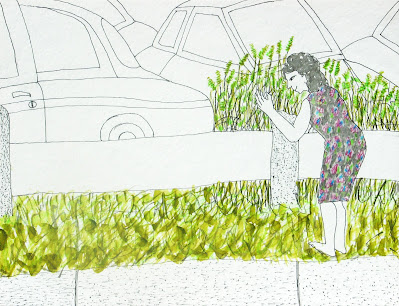If you walk east along Greenpoint Avenue in Brooklyn, you’ll find Calvary Cemetery next to the BQE highway. Just like the buildings lined up in Manhattan, the gravestones in this cemetery stand in neat rows. Sometimes I go in and read the inscriptions, spending quiet moments in peaceful silence.
As I walk through the cemetery, I read names and try to guess where the people were from, when they were born, when they died, and how long they lived. It’s not hard to find gravestones from the 1700s. I once wiped the dusty glass of a mausoleum window and looked inside. There were drawer-like shelves stacked on top of each other, each holding a coffin. On the drawers that hold someone’s remains, names and birth/death years are written. Some drawers are still empty, waiting for a future family member.
They say you don’t feel anything after death, but I still wouldn’t want to end up in one of those cold, dark drawers.
Walking through Calvary feels like stepping into a medieval village. There’s a large church in the center, built to comfort the dead, and around it stand big mausoleums, with smaller ones lined up nearby. Tall, carved headstones come next, and then smaller and smaller gravestones follow.
Closer to the BQE, the graves become more plain and humble. It makes me wonder—are the higher spots with views of the Manhattan skyline more expensive?
So far, I haven’t seen any gravestones with Korean names.
Rich people lie in grand mausoleums built with heavy stone, like luxury mansions. Those who died poor seem to be buried along the noisy highway, almost as if they’ve been cast aside. It feels like, during the day, the souls stay quietly hidden, but once night falls, they rise and begin to move, just like we do. The wealthy spirits might throw fancy parties, while the poor ones follow them around, serving them—just like in real life. That’s the kind of “community” I imagine.
Many Italian Catholics are buried in Calvary Cemetery. A few years ago, an Italian friend in my neighborhood lost her young daughter. She didn’t want to bury her far away, so she chose this cemetery, close to home. She complained about how expensive the plots were, but still visits often—like taking a walk. Unlike Koreans, who mostly visit ancestors only on special days, it seems Italians feel closer to their dead. To them, the relationship doesn’t feel distant, even after death.
I used to think death was the end—eternal rest. But what I see in Calvary Cemetery feels different.
Here, death looks more like a continuation of life, and even… a kind of struggle.
+I+am+a+matchmaker..jpg)


